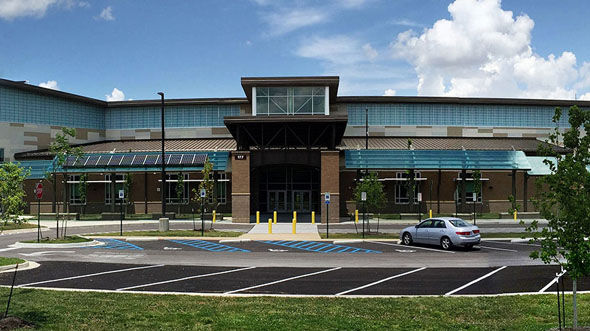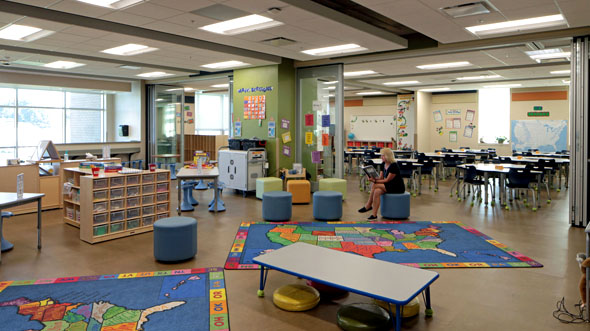
BLOG
—
K-12 Schools Can Leverage Federal Funding to Improve Facilities for Now, Future
Public school districts across the country are making plans for the second round of COVID-19 relief funding that has been allocated to help schools safely reopen and operate. The funds can be used in a variety of ways to lessen the impact of the pandemic and create healthier learning environments, including improving air and water quality by upgrading HVAC and water systems.
More than $54 billion has been distributed to states through the Elementary and Secondary School Emergency Relief (ESSER) Fund as part of the 2021 Coronavirus Response and Relief Supplemental Appropriations Act. States must allocate the funds to the local districts within one year, so time is of the essence. School leaders must take certain measures and file the appropriate paperwork specific to their state’s requirements to be eligible to receive the funds.
Similar to the first round of funding distributed last year under ESSER I, ESSER II funds can be used to cover costs incurred after March 13, 2020, when the national emergency was declared. ESSER I funds must be utilized by Sept. 30, 2022, and ESSER II funds must be used by Sept. 30, 2023. The federal grant program requires schools to track and report the use of the funds separately.
Woolpert has provided consulting services and worked on capital projects for K-12 institutions in multiple states and can assist school leaders in applying for ESSER funds and advise on how best to use the funds that are available.
Facilities Condition Assessments
As K-12 students return to the classroom, building administrators are taking steps to ensure classrooms are as safe as possible. Comprehensive condition assessments of facilities can encompass virtually every feature inside and outside a school building—from determining the serviceable life of roofs, doors and windows to evaluating the efficiency and health of HVAC and water systems. In addition to identifying deficiencies and establishing estimated lifecycles for assets, facilities assessments should provide the best corrective actions to take and help school leaders prioritize projects through evaluating needs and cost estimates.
Evaluating Space and Furniture
ESSER II funds can be used to evaluate facility space and furniture configurations to optimize educational space before and after social distancing measures are in place. Reconfiguring how areas are used for optimal safety and cleanliness can involve integrating sanitizing stations, utilizing more flexible furniture to increase space between teachers and students, and introducing unobtrusive barriers for visitors.
Ensuring Healthy Air and Water
Many school buildings could benefit from advances in HVAC technology to improve indoor air quality and create more energy efficiencies in their heating and ventilation systems. HVAC systems should be investigated to determine whether they reduce or increase the spread of pathogens. Older systems can be restored to optimal performance and retrofitted with enhancements that significantly increase the healthiness of the air.
In addition to investigating the conditions of components and systems controls, a comprehensive HVAC system assessment involves measuring carbon dioxide levels and monitoring room temperatures and humidity. This helps to narrow down where problems exist and how to fix them. Special financing programs are available to educational institutions that allow them to leverage long-term energy cost savings.
Unlike assessing heating and ventilation in a building, understanding the health of a building’s water system requires running tests at times of peak usage and when the system is dormant or has been shut down for an extended time. Water can stagnate in pipes when a building is not occupied, which can introduce pathogens into the system. However, measures can be taken to reduce the risk of harmful pathogens building up in plumbing infrastructure.
While upgrading equipment and fixtures in a system can improve water quality and efficiencies, water management strategies should be implemented to reduce risk to building occupants, regardless of how frequently the building is occupied.
Smart Building Technology and Planning for the Future
The network of wired and wireless communications and the control and monitoring systems within a building can be viewed as an ecosystem. When operating efficiently and effectively, the combined systems provide building occupants a safe, comfortable, well-connected and well-lit environment. Engineers and building technicians specialize in bringing together otherwise separate systems and advising facilities managers how best to implement smart, incremental strategies to manage building technology.
While addressing concerns that have surfaced during the pandemic is the top priority for schools today, leaders should not lose sight of the importance of resilience and environmental sustainability for the future. Analyzing past events and future projections can help identify looming natural and manmade hazards and define risk scenarios for contingency planning. Can the school building continue functioning during an extended power outage? What are the vulnerabilities of the school’s most critical assets and infrastructure? Are there strategies in place to recapture and reuse water? These questions and identifying the immediate and long-term costs can be addressed in planning charettes.
As the role of schools in a community have evolved, they increasingly provide stability and structure for individuals and families in both tangible and intangible ways. Elementary and secondary education are key factors in determining an individual’s future success. Sporting events and extracurricular activities are not only vital for the mental and physical well-being of students, they can galvanize communities and bring families together.
Our architecture, engineering, geospatial and strategic consulting experts are working to ensure school buildings continue to provide healthy, sustainable learning environments today and well into the future.



